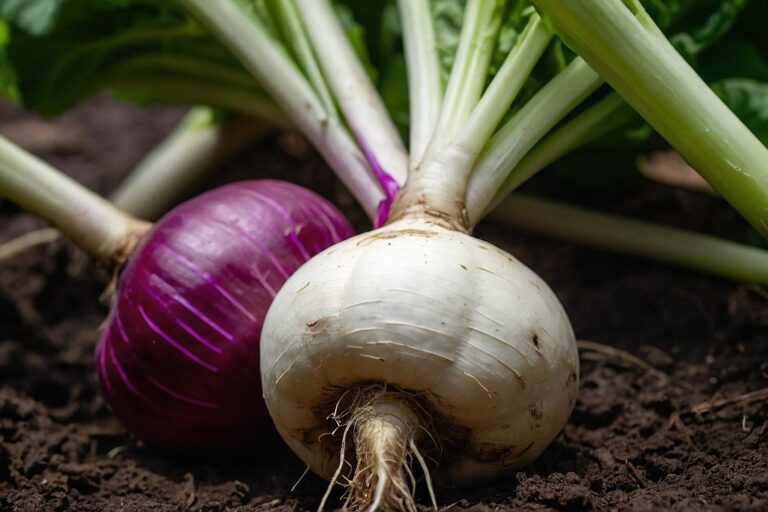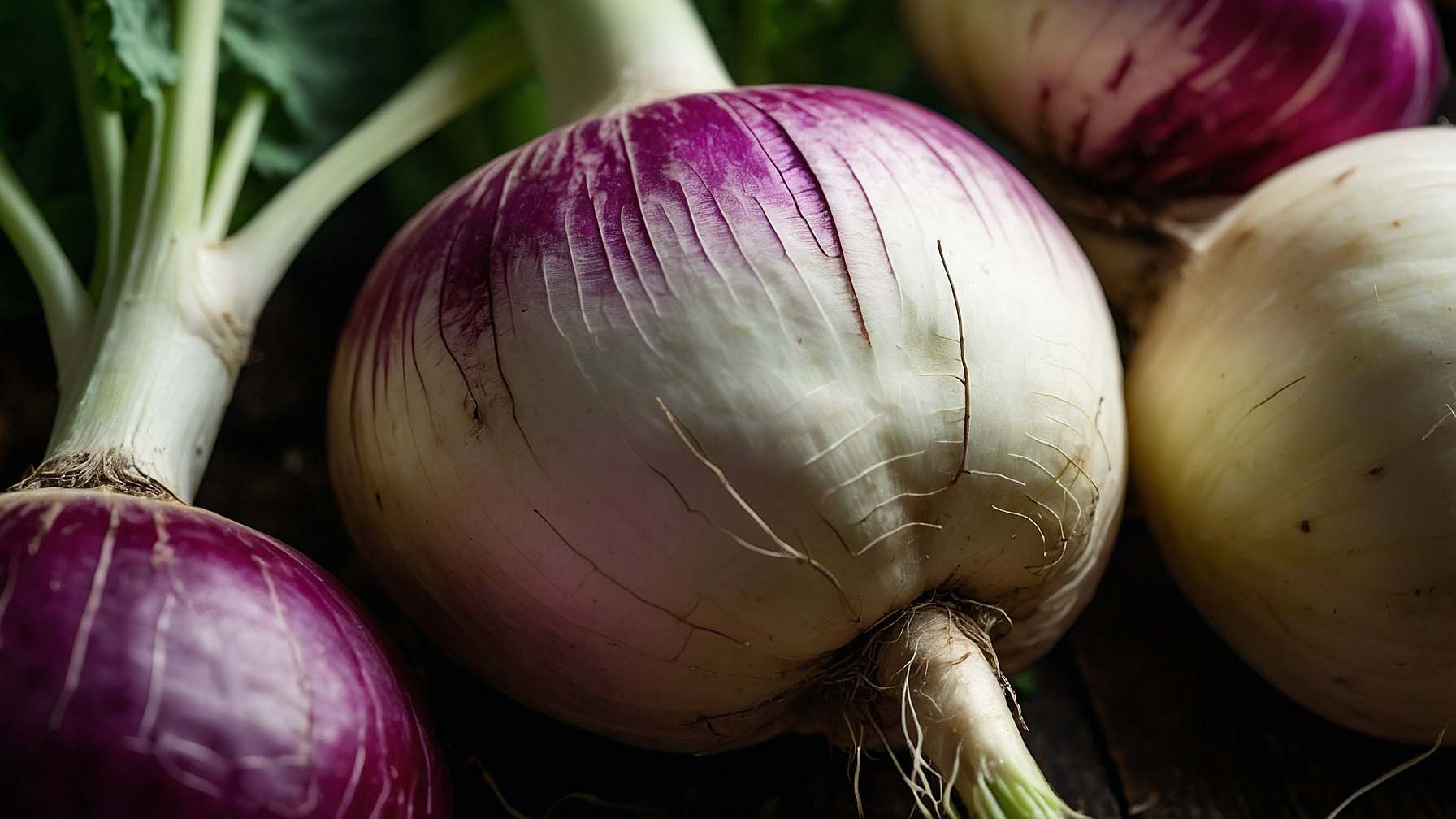Turnips are round, root vegetables with a white bottom and a purple, red, or greenish upper part. The taproot generally has a crisp, white flesh inside.
Root vegetables like turnips are nutritious staples boasting versatility in the kitchen and a host of health benefits. They can range in size from small, like a radish, to as large as a butternut squash. The taste of a turnip is slightly peppery, with a texture comparable to that of a crunchy radish when raw, which softens when cooked.
Unveiling the Humble Turnip

The turnip – often overlooked, yet full of surprises. This root vegetable brings a unique charm to the table. Laden with history, it has nourished generations. Visually, turnips are quite the spectacle. Let’s delve into the world of turnips, exploring what sets them apart from their earthy brethren.
Identifying Features of Turnips
Turnips reveal a rounded shape, with sizes varying from small to large. Their skin can be smooth or slightly textured. Contrast is key; their roots range from white to purple. Here’s a quick guide to recognising a turnip:
- Color: The top is purple, bottom white.
- Shape: Rounded at the base, tapering off.
- Texture: Smooth skin, with occasional leafy greens.
- Taste: Earthy, sometimes with a hint of sweetness.
Varieties and Their Unique Appearances
Not all turnips look alike. Various types boast unique colors, shapes, and sizes. Let’s peek at a few:
| Type | Color | Size |
|---|---|---|
| Purple Top | Purple and White | Medium to Large |
| Golden Globe | Yellow | Small to Medium |
| Scarlet Queen | Red and White | Small to Medium |
| Snowball | White | Small |
Each variety dresses up dishes with its unique flavor and color palette. The Purple Top is a classic, easily recognized by its purple crown. Golden Globe adds a touch of sunshine with its yellow skin. The Scarlet Queen boasts a vibrant red, and the Snowball, true to its name, is a pure white beauty.
Learn more: Quick Pickled Turnips
From Soil to Sight
Welcome to the journey ‘From Soil to Sight’. Let’s explore the world of turnips, a versatile root vegetable that graces many gardens and plates with its presence. From its early beginnings beneath the soil to the moment it adorns our tables, turnips undergo an amazing transformation. Get ready to unearth the secrets of their growth and appearance!
Growth Stages of Turnips
Turnips start their life as tiny seeds planted in fertile soil. Groups of leaves, known as ‘rosettes’, soon emerge, hinting at the magic happening underground. Below, the taproot thickens, storing nutrients. The flesh changes from white to a mix of purple, red, or green at the top, as the root matures. Here’s a breakdown of the stages you’ll witness:
- Germination: The seed sprouts and a seedling grows.
- Leaf development: Groups of leaves form a dense rosette.
- Root bulking: The turnip bulb expands and takes shape.
- Maturity: Leaves are lush and the root reaches full size.
Harvesting and Post-harvest Characteristics
Harvesting turnips is a delicate balance of timing and technique. Mature turnips boast a firm texture and a sweet, slightly spicy flavor. The ideal size for harvest is when they’re about the size of a tennis ball, ensuring a tender bite. Store them in a cool, dark place to maintain freshness. Here’s what to expect:
| Size at Harvest | Texture | Flavor | Storage Method |
|---|---|---|---|
| Tennis ball-sized | Firm | Sweet and slightly spicy | Cool, dark place |
Post-harvest, turnips may continue to harden, so it’s best to consume them while they’re fresh. Their smooth skin, once washed, showcases the earthly hues, and when sliced, the creamy white interior is revealed, often with tinges of purple or pink near the outer edges.
A Palette of Colors and Textures
Turnips aren’t just a culinary delight; they’re a visual feast too. Under the broad umbrella of ‘A Palette of Colors and Textures’, these root vegetables present a show-stopping array of hues and tactile experiences. Delve into the vibrant world of turnips, where every turnip is a masterpiece of nature’s artwork.
The Color Spectrum of Turnips
The shades of turnips stretch across a vivid spectrum. Beginning with the classic white, turnips can transition through a painting of purples, rosy reds, and even sun kissed yellows. Each color hints at the unique variety and flavor profile that turnips bring to the table. Here’s a glimpse into their colorful world:
- White: The quintessential look of the classic turnip.
- Purple: A royal hue often crowning the top of the root.
- Red: A blush of vibrant red decorating white spheres.
- Yellow: Soft, buttery shades making for mellow tastes.
Textures: From Smooth to Hairy
Not just a color show, turnips bring a dynamic range of textures. The outer skin ranges from smooth and clean to rough and shaggy. Smaller, young turnips often boast a delicate, tender feel, while larger, more mature ones may have a thick, hairy appearance. Depending on the age and variety, here are some textures you might encounter:
- Smooth: Young and tender with a silk-like surface.
- Textured: Mature with a more pronounced, rough feel.
- Hairy: Older turnips may display a tougher outer skin.
Size Matters: Understanding Turnip Dimensions
Ever peek into a garden and spot a bunch of leafy greens with hidden bulbs? Those buried treasures could be turnips! Turnip dimensions vary a lot. Some are as small as golf balls, others as big as a softball!
Typical Sizes of Turnips
Walk into a farmer’s market and you’ll see turnips of different sizes. Here’s what to expect:
- Small: around 2 inches in diameter – sweet and tender!
- Medium: about 3 to 4 inches – the most common size for cooking.
- Large: up to 6 inches – great for hearty dishes.
Giant Variants and Miniatures
Turnips are not just small, medium, or large. Some are ginormous, and some are tiny!
| Type | Size (Diameter) | Use |
|---|---|---|
| Giant Turnips | up to 20 inches or more | Often used for contests or animal feed. |
| Miniature Turnips | less than 2 inches | Ideal for pickles or raw snacks. |
Giant turnips can weigh a bunch! But, smaller mini turnips are crunchy and cute.
When Turnips Deceive: Look-alikes and Confusions
Turnips, with their crisp white flesh and purple-tinged tops, often find themselves mistaken for their look-alikes. Identifying turnips in a sea of root vegetables can be tricky. It’s crucial to distinguish them, as each root has its unique flavor and texture. This section will resolve the mystery and clarify common confusions.
Common Confusions with Rutabagas
Rutabagas and turnips are close relatives, but there are noticeable differences. Rutabagas are larger with a yellowish flesh, while turnips are comparatively smaller and mostly white inside. Shoppers often mix up these two veggies.
Let’s look at key features to tell them apart:
| Feature | Turnip | Rutabaga |
|---|---|---|
| Size | Smaller | Larger |
| Color | White with purple top | Yellowish flesh |
| Skin | Thin and smooth | Thick and waxy |
Spotting the Differences
Recognizing a turnip is simple if you know what to look for. Touch the skin: it should feel smooth, not waxy. Assess the size: turnips are usually the size of a tennis ball. Check the color: a blend of white and purple is the turnip’s signature.
- Smooth, not waxy skin
- Tennis ball-sized
- White with purple coloration
Conclusion
Wrapping up our root vegetable journey, we’ve peeled back the mystique of turnips. Now, with a clear image of their appearance and variety in mind, you’re well-prepared to spot them in your next market visit. Embrace the humble turnip and bring a new player to your culinary adventures.
See all in at Farm Pioneer for knowledge based for Turnips.
